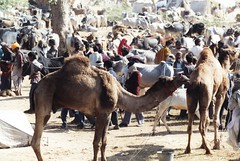 The city of Sawai Madhopur was established in 1765 AD by Sawai Madho Singh-I of Jaipur. Located in the eastern part of Rajasthan, Sawai Madhopur was built as a planned city. During this period, the Maratha rulers of Western India were gradually increasing their influence in this region. In order to check the incursions of the Marathas, Sawai Madho Singh-I fortified the village of Sherpur in 1763 AD. This was the genesis of the city of Sawai Madhopur which was only about 180 kms to the north-east of Jaipur, along the hills of Vindhyas and the Aravalli ranges.
The city of Sawai Madhopur was established in 1765 AD by Sawai Madho Singh-I of Jaipur. Located in the eastern part of Rajasthan, Sawai Madhopur was built as a planned city. During this period, the Maratha rulers of Western India were gradually increasing their influence in this region. In order to check the incursions of the Marathas, Sawai Madho Singh-I fortified the village of Sherpur in 1763 AD. This was the genesis of the city of Sawai Madhopur which was only about 180 kms to the north-east of Jaipur, along the hills of Vindhyas and the Aravalli ranges.
Sawai Madhopur has a rich history preceding the construction of the city. Madho Singh was the second son of Maharaja Sawai Jai Singh II, the founder of the city of Jaipur. Madho Singh was born in 1728 AD, 20 years after the marriage of Jai Singh II and Maharani Chandra, the princess of Sisodias (Mewar). The matrimonial alliance with Mewar was established on the condition that Princess Chandra’s son would inherit the throne of the Kachwaha (Jaipur) Kingdom. The succession was denied to Madho Singh and his older step-brother, Ishwar Singh was installed after the death of Maharaja Sawai Jai Singh in 1743 AD.
The new Maharaja was not acceptable to Madho Singh at all. Udaipur (Sisodias) sent their forces to Jaipur almost immediately, demanding the coronation of the rightful successor. Sawai Ishwari Singh resisted the pressure and fought his step-brother, Madho Singh, for seven long years. The rebellion continued and Madho Singh was joined by not only Udaipur but also the Marathas. The Kingdoms of Bundi and Kota also joined the struggle to depose Ishwari Singh. The 29 years old monarch was betrayed by his own Prime Minister and Commander-in-Chief, Hargovind Natani. Sawai Ishwari Singh decided not to fight till death instead committed suicide in 1750 AD and ended the struggle for succession.
The oldest monument in Sawai Madhopur District is the Ranthambore Fort, built in 944 AD by the Chauhan Rajput King Sapaldaksha. The Fort is located 700 feet above the surrounding area and commanded a strategic location. After the defeat of Prithviraj Chauhan at the hands of Muhammad Ghori in 1192 AD, Govinda, the grandson of Prithviraj established himself at Ranthambore. Govinda Raja was succeeded by his son Balhana. The Fort had its golden period from 1282 AD till 1301 AD, during the reign of Rao Hammir, the last ruler of the Chauhan dynasty.
Alauddin Khilji, the ruler of Delhi, conquered the Ranthambore Fort in 1301 AD, after three unsuccessful attempts. For the next three centuries, the Fort changed hands a number of times. Finally the Mughal Emperor Akbar took over the Ranthambore Fort and dissolved the Vassal State of Ranthambore in 1558 AD. The Fortress was restored to the Kachwahas (Maharaja Sawai Madho Singh-I of Jaipur) by the Mughals (Emperor Shah Alam) in 1765 AD and it remained part of Jaipur State until the Independence of India in 1947 AD.
During the 18th century, the forests of Ranthambore were the private and exclusive hunting reserves of Sawai Madho Singh-I of Jaipur. These forests are located at the confluence of the Aravalli Hills and the Vindhyas mountain range. The erstwhile rulers of Jaipur felt the need to preserve the area. This world famous wildlife reserve was established in 1955 AD and was called Sawai Madhopur Wildlife Sanctuary. The Maharaja of Jaipur was permitted to hunt in the Sanctuary till 1970 AD, after that hunting was banned completely. The Sanctuary, covering an area of 392 sq km, was included in the Project Tiger in 1973 AD. Sawai Madhopur Wildlife Sanctuary, Ranthambore, attained the status of a National Park in 1980 AD.






























